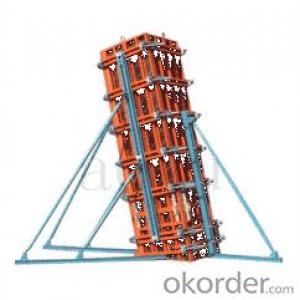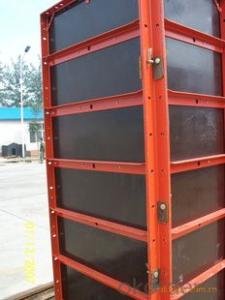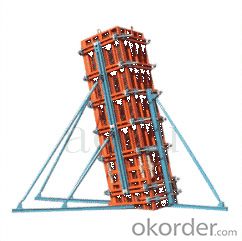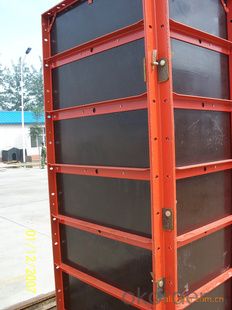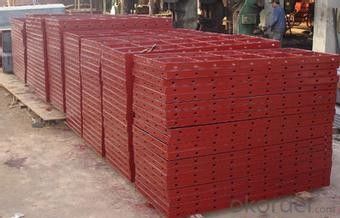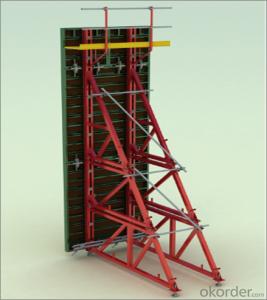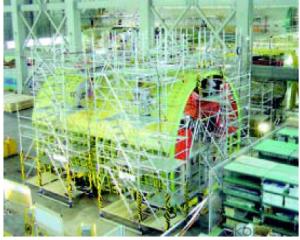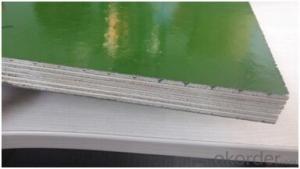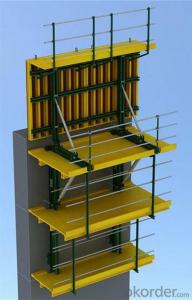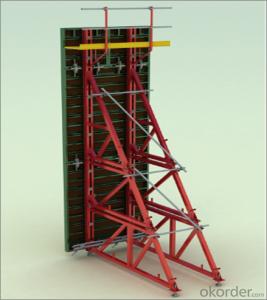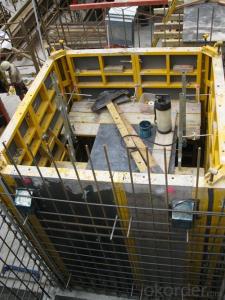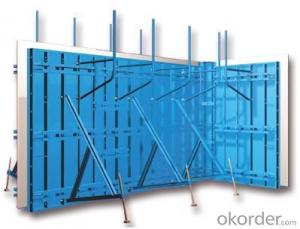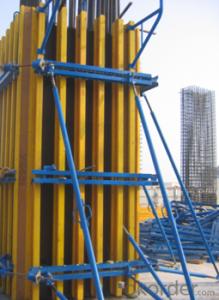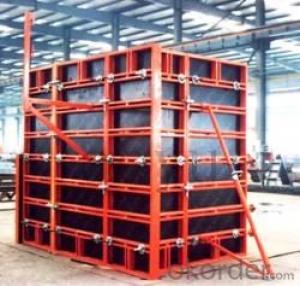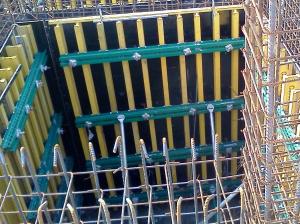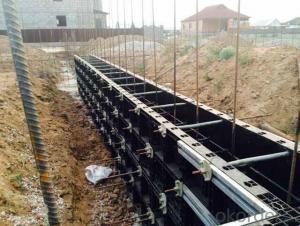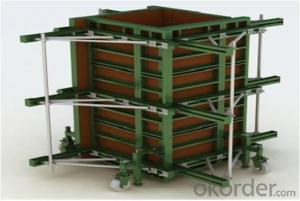Steel Frame Formworks with Different Kinds and Use for Construction
- Loading Port:
- Shanghai
- Payment Terms:
- TT or LC
- Min Order Qty:
- 1 m²
- Supply Capability:
- 100000 m²/month
OKorder Service Pledge
OKorder Financial Service
You Might Also Like
1. Structure of Steel Frame Formwork GK120 Description
There is a prizing part designed in the corner, which can help to position and remove formwork easily.The plywood is screwed on from the back when connecting frame and plywood, so the surface of the finished concrete is perfect.The formwork series are a complete system with a full set of accessories, and can be set up flexibly according to project demand.
2. Main Features of Steel Frame Formwork GK120
-convenient for construction
-easy to control the quality
-easy, rapid and economical.
3. Steel Frame Formwork GK120 Images
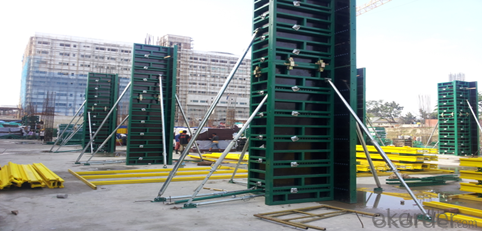
4. Steel Frame Formwork GK120Specifications
Steel Frame Formwork GK120 is used for the concrete pouring of square or rectangle column. The system has the same structure and similar connection type with wall formwork.
5.Steel Frame Formwork GK120
1) What can we do for you?
.We can ensure the quality of the Steel Frame Formwork GK120 and avoid extra expenses for customers.
.We can provide you the professional technical team.
.We can provide professional building proposal for your projects.
2) What promises can be done by us?
. If interested in this kind of formwork, please feel free to write us for any QUOTE.
. If need any technical and building assistance, we could provide on-site professional staff for instruction.
. Please DO check goods when courier knocks your door and contact us asap if any issueS.
3) What about of our after-sale services?
. Response will be carried out in 24hours after receiving any complain or request.
. Any formwork cost can be refund after order is confirmed.
. If the products are not based on the requirements, there will be the relevant compensations made for you.
4) What about the package and shipping time?
.Packing: wood package and adhesive tape
.Shipping: by sea
Shipping time: Normally small orders, it just1week business days to arrive your hand; When comes to the customs declaration, it may need 2weeks.
- Q: Can steel frame formwork be used for both precast and cast-in-place concrete beams?
- Both precast and cast-in-place concrete beams can utilize steel frame formwork. This adaptable and sturdy system can easily be adjusted to different construction approaches. When it comes to precast beams, the steel frame formwork is employed to fashion the mold or template where the concrete is poured and left to solidify. Once the concrete has hardened, the formwork can be taken off, resulting in a precast beam that can be transported and installed at the construction site. Similarly, for cast-in-place concrete beams, steel frame formwork is used to create a temporary mold or template for pouring the concrete. The formwork provides support and structure to the concrete during the pouring and solidifying process. Once the concrete has set, the formwork can be removed, leaving behind a cast-in-place beam that becomes an integral part of the overall structure. Steel frame formwork offers numerous benefits for both precast and cast-in-place beams. It provides exceptional strength and stability, enabling the creation of beams with intricate shapes and sizes. The steel frame formwork is easily assembled and disassembled, making it efficient and cost-effective. Additionally, it is reusable, reducing waste and promoting sustainability in construction projects. In conclusion, steel frame formwork is a suitable option for both precast and cast-in-place concrete beams. Its versatility, durability, and user-friendly nature make it the preferred formwork system for various construction methods.
- Q: Does steel frame formwork require any additional support or bracing during the concrete pouring process?
- Typically, during the concrete pouring process, steel frame formwork necessitates additional support or bracing. This is due to the substantial pressure exerted by the weight of the wet concrete on the formwork. In the absence of sufficient support, the formwork may distort or collapse. By providing extra support or bracing, the load can be evenly distributed, guaranteeing the formwork's stability and rigidity throughout the pouring process. It is crucial to meticulously plan and design the support system to cater to the unique demands of the construction project and safeguard the formwork's safety and integrity.
- Q: Steel frame wood fire doors and steel doors is a concept
- Steel frame wood fire doors and steel doors is not a concept: filling the former for fire insulation materials; the latter is filled using wooden, paper shell and other environmental protection material interior door.
- Q: What are the key components of steel frame formwork?
- The key components of a steel frame formwork are the steel panels, connectors, and accessories. 1. Steel Panels: These are the main structural elements of the formwork system. They are typically made of high-quality steel and are designed to be rigid and durable. The panels are available in various sizes and shapes, depending on the specific requirements of the project. They are used to create the vertical and horizontal surfaces of the formwork, providing the necessary support and containment for the concrete during pouring and curing. 2. Connectors: Connectors are used to join the steel panels together, forming a rigid and stable framework. These connectors come in different types, such as clamps, pins, bolts, and wedges. They are designed to securely fasten the panels and ensure that they remain in place during the concrete pouring process. Connectors also allow for easy assembly and disassembly of the formwork system, making it reusable for multiple projects. 3. Accessories: Various accessories are used to enhance the functionality and efficiency of the steel frame formwork. These include adjustable props, braces, ties, and wedges. Adjustable props are used to provide additional support and stability to the formwork system, especially for taller structures. Braces are used to reinforce the formwork and prevent any distortion or movement during concrete pouring. Ties are used to secure the formwork to existing structures or to other parts of the formwork system. Wedges are used to tighten and lock the connectors, ensuring the stability and integrity of the formwork. Overall, the key components of a steel frame formwork system work together to create a strong, durable, and adjustable structure that can be used repeatedly for various construction projects.
- Q: Can steel frame formwork be used for both permanent and temporary formwork systems?
- Yes, steel frame formwork can be used for both permanent and temporary formwork systems. Steel frame formwork is durable, strong, and can withstand the pressures exerted by concrete during the pouring and setting process. This makes it suitable for permanent structures where the formwork needs to remain in place as a permanent part of the structure. On the other hand, steel frame formwork is also easily adjustable and reusable, making it suitable for temporary formwork systems. It can be quickly assembled and disassembled, allowing for efficient construction processes. Additionally, the robust nature of steel frame formwork ensures that it can be used repeatedly without compromising its structural integrity. Overall, steel frame formwork provides flexibility and versatility, making it suitable for both permanent and temporary formwork systems.
- Q: Can steel frame formwork be used for both above-ground and below-ground construction?
- Yes, steel frame formwork can be used for both above-ground and below-ground construction. The robustness and durability of steel make it suitable for various construction applications, including both the construction of above-ground structures like buildings and below-ground structures like basements or foundations. Steel formwork provides a strong and stable support system that can withstand the pressures and loads associated with both types of construction.
- Q: What are the different types of supports and props used with steel frame formwork?
- Some of the different types of supports and props used with steel frame formwork include adjustable steel props, scaffolding systems, wall braces, diagonal braces, and horizontal supports. These supports and props are used to provide stability and reinforcement to the formwork system, ensuring that it can withstand the weight of the concrete being poured and maintain its shape during the curing process.
- Q: How does steel frame formwork handle different types of concrete additives?
- Steel frame formwork is a versatile and durable system that can effectively handle different types of concrete additives. These additives are commonly used to enhance specific properties of the concrete, such as strength, durability, workability, and setting time. The steel frame formwork is constructed using high-quality steel, which provides excellent strength and stability. This allows it to withstand the increased pressure and potential chemical reactions that may occur when using concrete additives. The steel frame is designed to support the weight of the concrete and any additional loads from the additives, ensuring that the formwork remains intact during the pouring and curing processes. Moreover, steel formwork is resistant to chemical reactions and corrosion, making it suitable for use with various types of concrete additives. Some additives, such as accelerators or plasticizers, can increase the setting time or improve the workability of the concrete. The steel formwork can handle the increased flowability of the concrete when these additives are used, ensuring a smooth pouring process and proper placement of the concrete. In addition, steel formwork can effectively handle concrete additives that enhance the strength and durability of the concrete, such as fibers or admixtures. These additives can improve the resistance to cracking, shrinkage, and chemical attacks. The steel frame formwork ensures that the concrete maintains its structural integrity and can withstand the additional stresses imposed by these additives. Furthermore, steel formwork can accommodate the use of different types of concrete additives without compromising the quality of the final product. The formwork system allows for easy customization and adjustment to accommodate the specific requirements of each project. It can be easily modified to accommodate the increased flowability or changes in the setting time caused by the additives. Overall, steel frame formwork is a reliable and effective system that can handle different types of concrete additives. Its strength, stability, and resistance to chemical reactions make it an ideal choice for projects that require the use of concrete additives to enhance the properties of the final product.
- Q: What are the different types of concrete finishes that can be achieved with steel frame formwork?
- There are several different types of concrete finishes that can be achieved with steel frame formwork. 1. Smooth Finish: This is the most common type of finish achieved with steel frame formwork. It creates a smooth and even surface that is suitable for most applications. This finish is achieved by properly preparing the formwork and ensuring that it is level and free of any debris or imperfections. 2. Exposed Aggregate Finish: This type of finish is achieved by removing the top layer of concrete to expose the aggregate (such as stones or pebbles) beneath. The steel frame formwork can be designed to accommodate this finish by incorporating removable top panels or by using a specialized formwork system that allows for easy removal of the top layer of concrete. 3. Stamped Finish: This type of finish is achieved by using steel frame formwork that has a pattern or texture on its surface. The formwork is pressed into the fresh concrete, creating a pattern or texture that resembles stone, brick, or other materials. This finish is commonly used to enhance the aesthetic appeal of concrete surfaces, such as driveways, walkways, and patios. 4. Polished Finish: This type of finish is achieved by using steel frame formwork that has a smooth and non-porous surface. Once the concrete has cured, it is polished using specialized equipment and diamond abrasive pads. This process creates a highly reflective and smooth surface that is often used in high-end residential and commercial applications. 5. Stained Finish: This type of finish is achieved by applying a chemical stain or dye to the surface of the concrete. The steel frame formwork can be designed to accommodate this finish by incorporating a release agent or by using a specialized formwork system that allows for easy application of the stain or dye. This finish is commonly used to add color and visual interest to concrete surfaces, such as floors, countertops, and walls. Overall, steel frame formwork provides versatility and flexibility in achieving different types of concrete finishes. With proper planning, preparation, and execution, these finishes can enhance the visual appeal and functionality of concrete structures.
- Q: Are there any specific considerations for using steel frame formwork in corrosive environments?
- Yes, there are several specific considerations for using steel frame formwork in corrosive environments. Firstly, it is important to choose the right type of steel for the formwork. Stainless steel, which contains high levels of chromium, is commonly used in corrosive environments as it has excellent corrosion resistance properties. It is resistant to rust and can withstand exposure to corrosive substances such as saltwater or chemicals. Secondly, the formwork needs to be properly coated or protected to prevent corrosion. This can be done through methods such as galvanization or applying protective coatings like epoxy or zinc-rich paint. These coatings act as a barrier, preventing corrosive agents from reaching the steel surface and causing damage. Additionally, regular maintenance and inspection are crucial to ensure the longevity of the steel formwork in a corrosive environment. This includes routine cleaning to remove any accumulated corrosive substances and conducting periodic inspections to identify any signs of corrosion or damage. Any detected corrosion should be promptly addressed and repaired to prevent further deterioration. Lastly, it is essential to consider the design and construction of the formwork to minimize the potential for corrosion. This may involve incorporating features such as proper drainage to prevent the accumulation of corrosive substances, avoiding the use of dissimilar metals that can cause galvanic corrosion, and ensuring proper ventilation to reduce moisture levels. Overall, using steel frame formwork in corrosive environments requires careful material selection, protective coatings, regular maintenance, and appropriate design considerations to ensure the durability and longevity of the formwork.
Send your message to us
Steel Frame Formworks with Different Kinds and Use for Construction
- Loading Port:
- Shanghai
- Payment Terms:
- TT or LC
- Min Order Qty:
- 1 m²
- Supply Capability:
- 100000 m²/month
OKorder Service Pledge
OKorder Financial Service
Similar products
Hot products
Hot Searches
